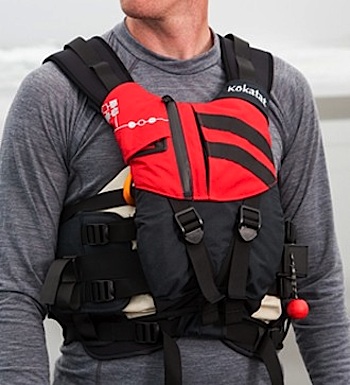If you're going to play in the water -- rivers, lakes, and oceans -- you're going to need a PFD, aka life preserver. Now, how hefty of a preserver, well, that's another matter.
Are you a trip leader, or merely baggage, a passenger on a float trip? Are you paddling white water, or lazy lakes? Those and other factors can go into your choice of PFD.
This summer I had the use of a Maximus Prime PFD from Kokatat, a California-based company that has been making paddling gear since 1971. The company's line ranges from PFDs and dry suits to insulating layers and even footwear for your paddling, and in some cases, portaging, comfort.
The Maximus Prime is at the high-end, a Type 5 white-water rescue PFD that is of particular value to paddlers who might find themselves in a white-water rescue situation. The jacket was standing in for a 20-year-old Type 3 jacket that, while still buoyant, didn't offer as much buoyancy or comfort as does the Maximus Prime and which, frankly, doesn't lend quite as much confidence if I found myself tossed out of a boat in a Class III rapid.
The Maximus Prime is a vast upgrade, and not simply because of the added buoyancy. The entire cut of the PFD is different, offering a deeper opening around the armpits that eliminates chaffing. The front flotation panel is suspended off the shoulder straps for better movement when you're paddling.
A range of straps on the jacket's front make it highly adjustible for a secure, comfortable fit. An O-ring on the quick-release safety harness on the back of the PFD permits you to attach a rescue line. A chest pocket can hold a snack or other small items, and there's an adjacent tab for attaching a rescue knife, a handy tool to slice through throw rope tangles if they're threatening your life.

The Maximus Prime.
The Maximus Prime, needless to say, is more than what the average paddler needs. There is a whole range of lesser vests that would suit those not in the rescue business just fine.
In the end, you want a vest that is secure and comfortable, that provides ample buoyancy for the conditions you'll be in.
When it comes to fitting a PFD, you can tell if one is too big for you if, once you've adjusted all the straps, someone can pull up on the shoulder straps and have the vest slide up over your face.
Extras you might consider are tabs on the vest that allow you to attach things such as rescue knives or strobe lights.
While regulations can vary on whether you need to be wearing a PFD while paddling, or merely have one in your boat, it's safer to wear your PFD whenever you're on the water. Trying to find it and put it on if your canoe or kayak capsizes or you're tossed from a raft could be tricky and risky.


 Support Essential Coverage of Essential Places
Support Essential Coverage of Essential Places







Comments
And then it transforms into a giant truck and drives away? Oh...that was Optimus...